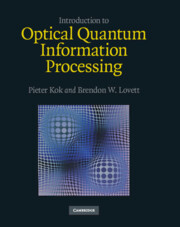Book contents
- Frontmatter
- Dedication
- Contents
- Preface
- Part I Quantum optics and quantum information
- Part II Quantum information in photons and atoms
- 4 Photon sources and detectors
- 5 Quantum communication with single photons
- 6 Quantum computation with single photons
- 7 Atomic quantum information carriers
- Part III Quantum information in many-body systems
- Appendix A Baker–Campbell–Haussdorff relations
- Appendix B The Knill–Laflamme–Milburn protocol
- Appendix C Cross–Kerr nonlinearities for single photons
- References
- Index
7 - Atomic quantum information carriers
from Part II - Quantum information in photons and atoms
Published online by Cambridge University Press: 05 July 2014
- Frontmatter
- Dedication
- Contents
- Preface
- Part I Quantum optics and quantum information
- Part II Quantum information in photons and atoms
- 4 Photon sources and detectors
- 5 Quantum communication with single photons
- 6 Quantum computation with single photons
- 7 Atomic quantum information carriers
- Part III Quantum information in many-body systems
- Appendix A Baker–Campbell–Haussdorff relations
- Appendix B The Knill–Laflamme–Milburn protocol
- Appendix C Cross–Kerr nonlinearities for single photons
- References
- Index
Summary
We have so far spoken almost exclusively of photons and linear-optical elements, and seen just how powerful those two components can be for information processing. They provide unbreakable cryptographic tools, and allow for efficient quantum computing. However, many more possibilities become available when we allow photons to interact with atoms and solid matter in a quantum mechanical way. In particular, a quantum memory, the principal difficulty for linear-optical quantum computing, can be created. In this chapter we will take the first steps towards a full understanding of a photon's interaction with atoms. We will show how to describe the interactions within a system consisting of photons and few-level atoms and show how this interaction can be manipulated and exploited to provide quantum information processors based on both atomic and photonic qubits. We will also show that photon emission from atoms can degrade the quantum information contained within atoms, and we will present a formalism to model this effect. We begin with a general discussion of atom-photon interactions.
Atomic systems as qubits
Let us first consider an electron in an isolated atom. It is bound there by the Coulomb force due to the charge distribution of all the other electrons and the nucleus. The potential that describes this coupling is given by V(r).
Information
- Type
- Chapter
- Information
- Introduction to Optical Quantum Information Processing , pp. 210 - 252Publisher: Cambridge University PressPrint publication year: 2010
